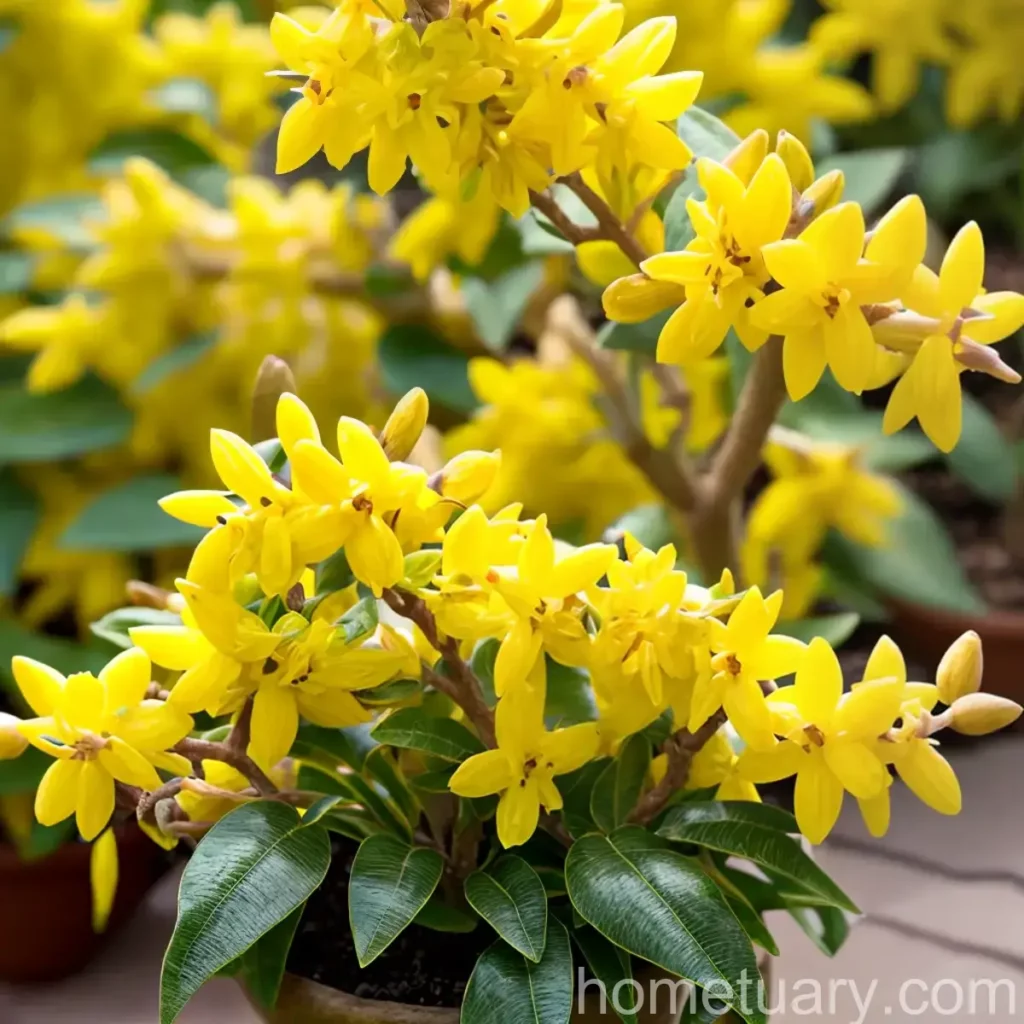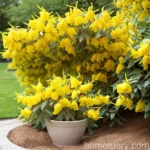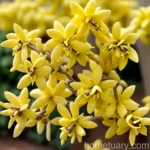The Beautiful Forsythia ‘Little Renee’: A Complete Guide
Forsythia ‘Little Renee’ is a stunning ornamental shrub that is cherished by many gardeners for its vibrant yellow blooms and elegant foliage. It is a popular choice for landscapes, gardens, and containers due to its compact size and low maintenance requirements. In this comprehensive guide, we will delve into the various aspects of this delightful plant, including its cultural needs, uses, propagation, common diseases, and much more.
What is Forsythia ‘Little Renee’?
Forsythia ‘Little Renee’, a member of the olive family (Oleaceae), is a deciduous shrub that is prized for its abundant, bell-shaped yellow flowers that bloom in early spring. This compact variety is a cultivar of Forsythia, renowned for its manageable size, making it an excellent choice for smaller gardens, tight spaces, and container plantings. Its botanical name, Forsythia ‘Little Renee’, pays homage to its unique and endearing characteristics.
The ‘Little Renee’ cultivar offers an array of features that elevate its desirability, such as its low maintenance needs, adaptability to various soil types, and its ability to thrive in full sun or partial shade. This charming shrub is an exceptional addition to any garden or landscape, adding a burst of color and warmth during the early spring months.
Key Takeaways: Forsythia ‘Little Renee’
Before delving into the specifics of cultivating and caring for Forsythia ‘Little Renee’, let’s summarize some key takeaways about this captivating shrub:
- Spring Blooms: Forsythia ‘Little Renee’ is renowned for its profusion of vibrant yellow blooms that adorn its branches in early spring, adding a splendid burst of color to the landscape.
- Compact Size: This cultivar is notably smaller in size compared to other Forsythia varieties, making it a perfect choice for gardens with limited space, urban gardens, and container plantings.
- Low Maintenance: Forsythia ‘Little Renee’ is relatively easy to care for, requiring minimal pruning and maintenance, making it an ideal option for busy gardeners.
- Versatile Uses: This shrub is a versatile addition to landscapes, offering the flexibility to be used as a standalone specimen, in group plantings, or as a border plant.
Now, let’s explore in detail the various aspects of caring for Forsythia ‘Little Renee’, including its cultural requirements, uses, propagation, common diseases, and more.
Culture
Water
Forsythia ‘Little Renee’ benefits from regular watering, particularly during its establishment phase and dry spells. Adequate moisture is crucial for promoting healthy growth and the development of vibrant blooms. A consistent watering schedule, ensuring the soil is evenly moist but not waterlogged, is essential, particularly during the growing season. However, once established, Forsythia ‘Little Renee’ displays moderate drought tolerance and can withstand short periods of dry conditions.
Sunlight
This variety thrives in full sun to partial shade. It is essential to provide the shrub with at least 6 hours of direct sunlight daily to encourage abundant flowering and robust growth. In regions with extremely hot summers, providing some afternoon shade can help prevent the plant from becoming stressed due to excessive heat. When grown in partial shade, the shrub may produce slightly fewer blooms, but its overall health and vigor should not be significantly impacted.
Fertilizer
To support the growth and blooming of Forsythia ‘Little Renee’, it is advisable to apply a balanced fertilizer in early spring, just before new growth emerges. A slow-release fertilizer or a granular fertilizer specifically formulated for flowering shrubs can be incorporated into the soil around the base of the plant. Following the manufacturer’s instructions regarding the application rate and frequency is recommended to avoid over-fertilization, which may lead to excessive foliage growth at the expense of blooms.
Soil
Forsythia ‘Little Renee’ adapts well to a variety of soil types, provided they are well-draining. However, the shrub thrives in moderately fertile, loamy soil with a slightly acidic to neutral pH. It is pertinent to ensure that the planting site offers good drainage to prevent waterlogging, which can compromise the root health of the shrub. Amending heavy clay soils with organic matter, such as compost or well-rotted manure, can improve soil structure and drainage.
Pruning
Pruning is an integral aspect of maintaining the health, shape, and blooming potential of Forsythia ‘Little Renee’. This cultivar blooms on old wood, which means that it sets its flower buds in the previous growing season. Therefore, to ensure prolific blooming, it is crucial to time the pruning correctly. The best time to prune Forsythia ‘Little Renee’ is immediately after it has finished flowering, typically in late spring or early summer.
The primary objective of pruning Forsythia ‘Little Renee’ is to remove dead, damaged, or diseased wood, promote a balanced and open growth habit, and rejuvenate older plants. Additionally, to encourage new growth and maintain the shrub’s compact shape, selectively removing some of the oldest stems at ground level can be beneficial. It is important to use sharp, clean pruning tools and to make precise cuts to prevent damaging the plant. When carrying out pruning, it is advisable to step back occasionally to assess the shrub’s overall shape and to ensure uniformity.
Propagation
Forsythia ‘Little Renee’ can be propagated through various methods, with the most common techniques being softwood cuttings, hardwood cuttings, and division. Each method has its advantages and considerations, and the success rates may vary based on the environmental conditions and the proficiency of the propagator.
-
Softwood Cuttings: Softwood cuttings, taken in late spring to early summer, offer a high success rate for propagating Forsythia ‘Little Renee’. Select healthy, non-flowering shoots and take 4- to 6-inch cuttings. Remove the lower leaves and dip the cut end in rooting hormone before inserting it into a well-draining, sterile propagation medium. Keep the cuttings consistently moist and provide bottom heat, if possible, to encourage root development. Once rooted, the young plants can be potted up or planted in a suitable location.
-
Hardwood Cuttings: Hardwood cuttings are typically taken in late autumn or winter when the shrub is dormant. Select sturdy, disease-free branches and cut them into 8- to 10-inch sections. Remove any soft or diseased wood and make a straight cut at the base and an angled cut at the tip to differentiate the top from the bottom. Dip the base in rooting hormone and insert the cuttings into a prepared nursery bed or container filled with a well-draining propagation medium. Keep the cuttings protected from harsh weather and ensure the medium remains consistently moist. The following spring, the rooted cuttings can be transplanted to a permanent location.
-
Division: Division is another viable method of propagating Forsythia ‘Little Renee’, particularly for mature specimens that have developed multiple stems or offshoots. When dividing the shrub, it is essential to dig up the entire root ball and carefully separate it into sections using a sharp spade. Each section should contain a good portion of the root system and several healthy shoots. Replant the divided sections in prepared soil and provide adequate water and care to ensure successful establishment.
Propagation can be a rewarding endeavor, offering the opportunity to create new plants from a cherished variety or to expand the garden with additional specimens.
Container Popularity
Forsythia ‘Little Renee’ is highly sought after for container plantings due to its manageable size, attractive blooms, and adaptability to growing in confined spaces. When growing Forsythia ‘Little Renee’ in containers, several factors should be considered to maximize the shrub’s health and flowering potential.
- Container Size: Select a container that provides ample room for the shrub’s root system to develop. A larger container not only accommodates the root growth but also offers stability to the plant, reducing the risk of it toppling over in windy conditions.
- Drainage: Ensure the container has adequate drainage holes to prevent waterlogging, which can lead to root rot and other moisture-related issues. Placing a layer of gravel or broken pottery shards at the base of the container before adding the potting mix can further enhance drainage.
- Potting Mix: Choose a well-draining potting mix formulated for shrubs and outdoor plants. A mix that contains a blend of organic matter, perlite, and coarse sand can provide the ideal balance of moisture retention and drainage.
- Watering and Fertilization: Container-grown plants may require more frequent watering and fertilization compared to their counterparts in the ground. Monitor the soil moisture regularly and provide water when the top inch of the soil feels dry. Additionally, incorporate a slow-release, balanced fertilizer into the potting mix in spring to support the plant’s growth and blooming.
Uses
Forsythia ‘Little Renee’ offers exceptional versatility, making it well-suited for a variety of uses in the landscape and garden. Here are several popular applications of this charming shrub:
- Specimen Plant: The vibrant yellow blooms and elegant foliage of Forsythia ‘Little Renee’ make it an excellent choice as a standalone specimen, where it can command attention and serve as a focal point of the garden.
- Border Planting: When planted in a linear arrangement along borders, walkways, or garden paths, Forsythia ‘Little Renee’ creates a striking visual impact with its profusion of spring blooms and graceful arching branches.
- Container Planting: Its compact size and manageable growth habit make Forsythia ‘Little Renee’ an ideal candidate for container plantings on patios, balconies, and in urban gardens, where it can infuse spaces with vibrant color and beauty.
- Mixed Plantings: Incorporating Forsythia ‘Little Renee’ into mixed plantings with other spring-blooming shrubs, perennials, and annuals adds depth, texture, and seasonal interest to the landscape, creating visually appealing compositions that evolve throughout the year.
The adaptability and aesthetic appeal of Forsythia ‘Little Renee’ render it an invaluable asset in a wide range of garden designs, offering boundless potential for creative and captivating arrangements.
Common Diseases
Forsythia ‘Little Renee’, like many ornamental shrubs, is susceptible to certain diseases that can impact its health and appearance. Being familiar with the common diseases and their associated symptoms is essential for prompt identification and intervention to mitigate their effects. Here are some prevalent diseases that may affect Forsythia ‘Little Renee’:
- Anthracnose: Anthracnose is a fungal disease that may manifest as dark lesions on the leaves, causing them to develop unsightly spots and, in severe cases, leading to premature leaf drop. To manage anthracnose, it is vital to maintain good air circulation around the shrub, prune out infected branches, and avoid overhead watering.
- Canker Diseases: Cankers, often caused by bacteria or fungi, present as sunken, discolored areas on the bark of branches, leading to dieback and general decline of the affected stems. To reduce the risk of canker diseases, it is crucial to provide proper cultural care, including regular watering, fertilization, and pruning, to bolster the shrub’s natural defenses.
- Powdery Mildew: Powdery mildew is a common fungal disease that appears as a powdery, white coating on the leaves, impairing their function and aesthetics. To manage this disease, it is advisable to avoid overhead watering, provide good air circulation, and apply appropriate fungicidal treatments as recommended.
Maintaining the overall health and vigor of Forsythia ‘Little Renee’ through proper cultural practices, regular monitoring, and timely intervention is essential for minimizing the impact of diseases.
Disease Diagnosis
When diagnosing potential diseases affecting Forsythia ‘Little Renee’, it is crucial to closely observe the plant’s symptoms and consider environmental factors that may contribute to the development and spread of diseases. Here are some steps to aid in the accurate diagnosis of diseases:
-
Symptom Observation: Carefully inspect the shrub for any visual abnormalities, such as discoloration, lesions, wilting, or deformities, present on the leaves, stems, or flowers. Documenting the specific symptoms and their location on the plant can provide valuable information for diagnosis.
-
Environmental Factors: Evaluate the environmental conditions surrounding the shrub, including factors such as humidity levels, air circulation, soil moisture, and sun exposure. Certain diseases, such as powdery mildew, may flourish under specific environmental conditions, aiding in narrowing down the potential culprits.
-
Professional Consultation: In cases where the symptoms are ambiguous or the diagnosis is uncertain, seeking the expertise of a plant pathologist or a horticultural specialist can be invaluable. Professionals can conduct in-depth assessments and diagnostic tests to pinpoint the underlying issues and recommend tailored treatments.
Proactive monitoring, swift intervention, and accurate diagnosis are pivotal in safeguarding the health and longevity of Forsythia ‘Little Renee’ and other ornamental plants.
Common Pests
Forsythia ‘Little Renee’ may fall victim to various pests that can compromise its health and vigor, potentially leading to diminished flowering and overall decline if left unchecked. Familiarizing oneself with the common pests and their characteristic signs can aid in early detection and informed pest management strategies.
Aphids
Aphids are small, soft-bodied insects that congregate on the undersides of leaves, where they feed on plant sap using their piercing mouthparts. An infestation of aphids may cause the leaves to become distorted, yellowed, or coated with sticky honeydew excreted by the insects. To control aphids, introducing natural predators, such as ladybugs or lacewings, and using insecticidal soaps can help reduce their populations.
Scale Insects
Scale insects, both armored and soft scales, are invasive pests that adhere to the stems and leaves of the plant, where they consume sap, leading to weakening and stunted growth. Physical removal of scale insects using a soft brush or cloth, coupled with horticultural oils or insecticidal treatments, can aid in managing their populations.
Spider Mites
Spider mites are minute arachnids that feed on the plant’s juices, often causing stippling, discoloration, and webbing on the leaves. Regularly spraying the foliage with a strong jet of water and introducing predatory mites or ladybugs can help mitigate spider mite infestations.
Caterpillars
Caterpillars, particularly those of certain moth species, can voraciously consume the foliage of Forsythia ‘Little Renee’, leading to defoliation and reduced vigor. Handpicking caterpillars from the shrub or utilizing biological pest control methods, such as Bacillus thuringiensis (Bt), can effectively manage caterpillar populations.
Vigilance, early detection, and promptly implementing pest control measures are pivotal in preserving the health and beauty of Forsythia ‘Little Renee’ and ensuring its resilience against pest pressures.
Botanist’s Tips
Successional Plantings for Extended Bloom
To maximize the impact of Forsythia ‘Little Renee’ in the landscape and extend the season of interest, consider incorporating successional plantings of spring-flowering plants. Pairing the vibrant yellow blooms of Forsythia ‘Little Renee’ with late-spring blooming bulbs, such as tulips and daffodils, or early-flowering perennials, including lungworts and candytuft, can create a harmonious and enduring display of color and beauty.
Seasonal Mulching for Moisture Retention
Applying a layer of organic mulch, such as shredded bark, compost, or pine straw, around the base of Forsythia ‘Little Renee’ offers multiple benefits. Mulching helps retain soil moisture, suppresses the growth of weeds, moderates soil temperature, and contributes to the enrichment of the soil as it decomposes. When mulching, maintain a distance of a few inches between the base of the shrub and the mulch to prevent excessive moisture retention around the stem.
Winter Protection through Mulching
In regions prone to harsh winter temperatures or erratic freeze-thaw cycles, providing a protective layer of mulch around the base of Forsythia ‘Little Renee’ in late fall or early winter can help insulate the roots and minimize the risk of damage. The mulch acts as an insulating barrier, shielding the roots from extreme temperature fluctuations and frost heaving, which can impact the shrub’s overall health.
Promoting Pollinator Diversity
Harnessing the nectar-rich blooms of Forsythia ‘Little Renee’ to attract and support a diverse range of pollinators is both beneficial to the garden ecosystem and rewarding for the gardener. By creating a pollinator-friendly environment through the inclusion of additional nectar and pollen sources, such as flowering herbs, perennials, and native plants, it is possible to sustain a thriving and diverse population of pollinators, including bees, butterflies, and beneficial insects.
Fun Facts
- Forsythia is named after William Forsyth, a prominent Scottish botanist and founding member of the Royal Horticultural Society.
- In traditional Chinese medicine, Forsythia suspensa is utilized for its purported medicinal properties, and its dried fruit is used in herbal preparations.
- The bright yellow flowers of Forsythia serve as an early nectar source for pollinators emerging from winter dormancy, aiding in the rejuvenation of local ecosystems.
In conclusion, the endearing characteristics, vibrant blooms, and modest demands of Forsythia ‘Little Renee’ make it an esteemed addition to gardens, landscapes, and containers. This versatile shrub thrives in a variety of cultural conditions, offers a profusion of spring blooms, and contributes to the charm and allure of the seasonal garden.
Links to External Resources
For further information and resources on Forsythia ‘Little Renee’, consider exploring the following websites and publications:
- Royal Horticultural Society – Offers comprehensive guidance on the cultivation and care of Forsythia ‘Little Renee’ and other ornamental shrubs.
- University Extension Websites – Various university extension websites provide educational materials, articles, and fact sheets on the cultivation and management of Forsythia ‘Little Renee’ for different regions.
- National Gardening Associations – Online gardening communities and associations often feature forums, articles, and resources related to the cultivation and uses of ornamental shrubs such as Forsythia ‘Little Renee’.
By exploring these external resources, enthusiasts can glean valuable insights, best practices, and practical tips for growing and enjoying Forsythia ‘Little Renee’ in their own gardens and landscapes.















